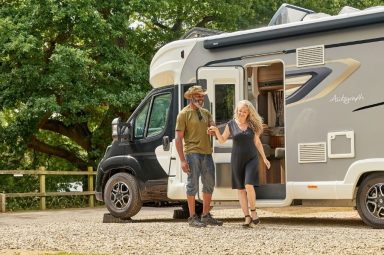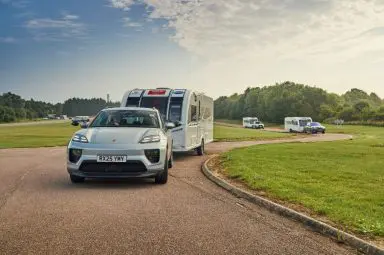Explore the Isle of Wight with your caravan
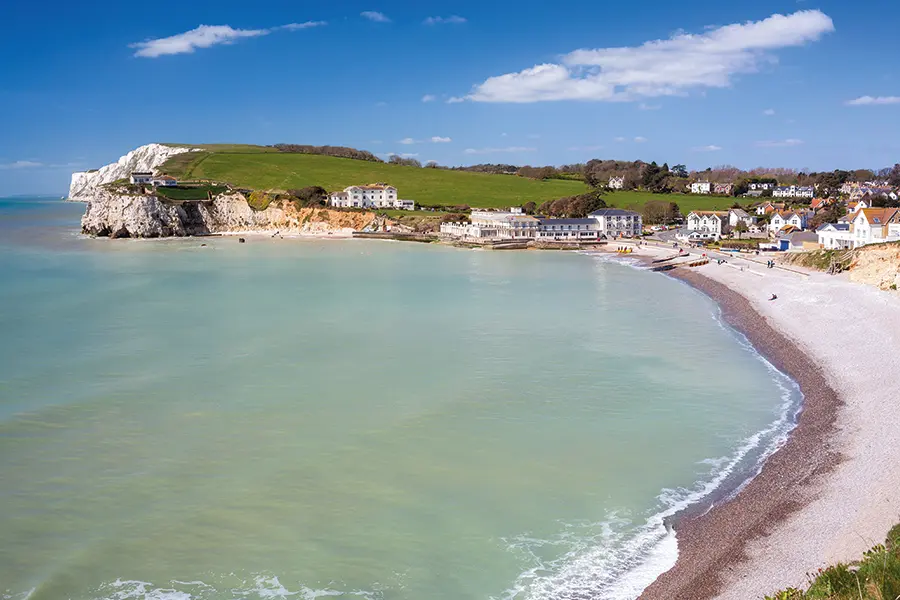
To get there, you need to take your caravan or motorhome on a ferry ride across the The Solent, with this mini cruise making a great start to your family holiday.
The island is well known for its mild climate, coastal scenery at Nodes Point and Whitecliff Bay, and verdant landscape of green fields. Additionally, it has one of the highest concentrations of dinosaur fossils anywhere in the world that it even has been dubbed the “Dinosaur Island”.
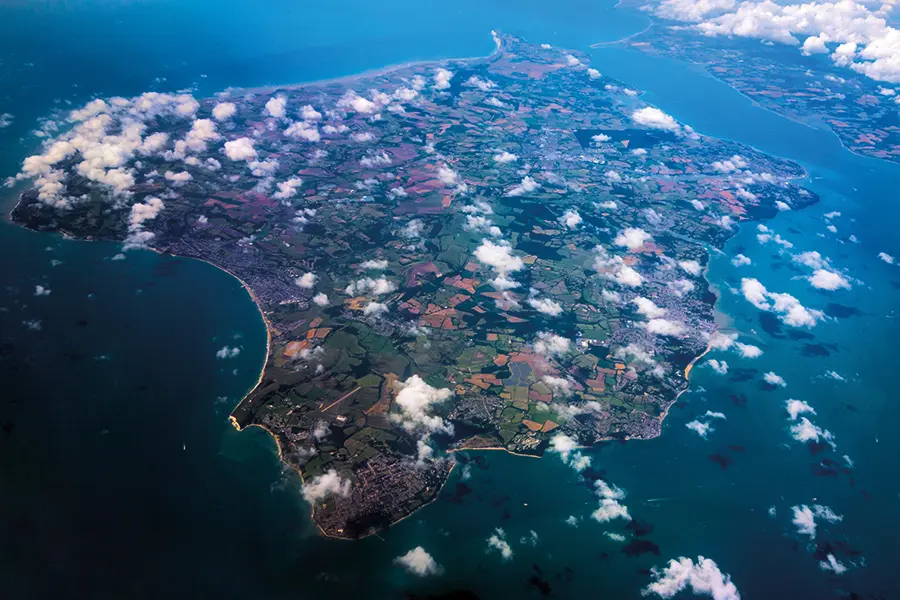
This article will shed light on the many historical and natural wonders on the Isle. We’ll also talk you through the best caravan sites you can visit, and the best places to eat and drink on the Isle of Wight.
- Do I need a passport to take my Caravan to the Isle of Wight?
- Where do I book a Caravan Camp Site on the Isle of Wight?
- What are some examples of great campsites to stay on the Isle of Wight?
- How do I get my caravan or motorhome to the Isle of Wight?
- Can I take a caravan or motorhome on the ferries?
- History of the Isle of Wight
- What is there to see on the Isle of Wight?
- Where is best to eat and drink as I caravan around the Isle of Wight?
Do I need a passport to take my caravan to the Isle of Wight?
Where do I book a caravan camp site on the Isle of Wight?
You can easily book a slot in a caravan campsite online now. When booking, it is important to consider a few steps:
Which part of the Island would you like to visit?
Although not a large island, it is nice to stay at a location which is close to a particular part of the island you would want to visit.
Discover what each part has to offer. Whether you are a history buff, animal lover, or a sailing enthusiast there is something on the Isle of Wight that will appeal to you.
Booking ahead of time
Many of the caravan and motorhome campsites on the Isle of Wight are either Caravan and Motorhome Club Certified Locations or Camping and Caravanning Club Certified Sites. This means that these are small, privately run campsites that operate under the jurisdiction of their respective clubs.
These campsites can only accommodate up to five caravans or motorhomes and up to ten trailer tents or tents and range from secluded hideaways to fully facilitated family-friendly sites.
The websites of both clubs feature a campsite finder making it easy for you to choose your campsites based on the area you want to visit, the kind of features you want it to have (e.g. dog-friendly, family-friendly), and the type of campsite you want (e.g. restaurant, play area for kids).
You can check out the Caravan And Motorhome Isle of Wight campsite finder here or the Camping and Caravanning Isle of Wight campsite finder here.
Choosing the right campsite is an important thing as it not only will serve as your temporary home and base for exploration but also as a source of entertainment and relaxation.
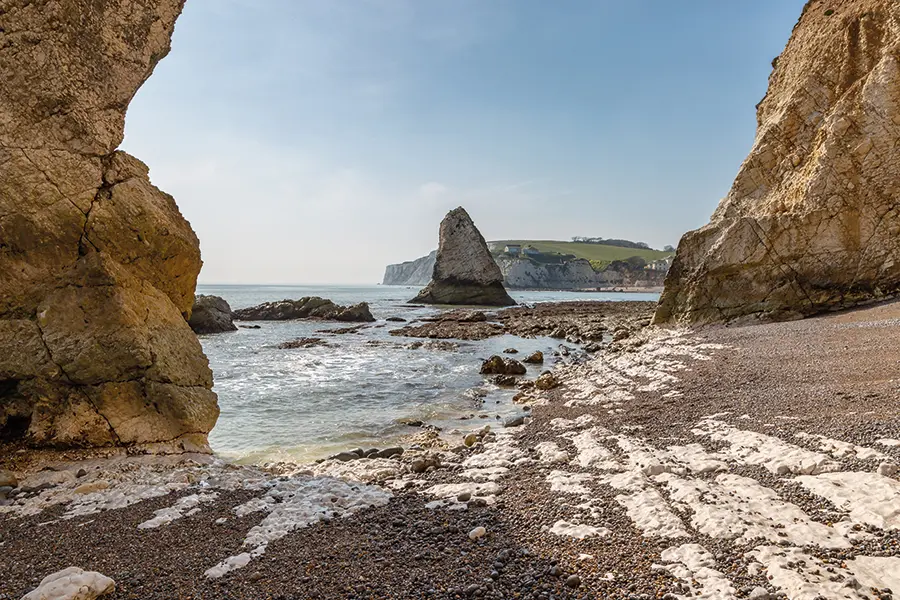
What are some examples of great campsites to stay on the Isle of Wight?
As previously stated, the Caravan and Motorhome Club and the Camping and Caravanning club provide excellent options for caravan camping sites.
Additionally, the official Isle of Wight tourism website has some fantastic caravans sites as well.
Here are some options for a caravan and motorhome campsite for your future trip to the Isle of Wight.
The Caravan and Motorhome Club
Winford Road, Newchurch, Sandown, Isle of Wight, PO36 OLZ
Amenities
- Caravan and Motorhome accessible
- Family and Pet friendly
- Large playground and play areas for children
- An excellent bus transport system
The Camping and Caravanning Club
Amenities
- Between Yarmouth and Newport
- Flushing toilet
- Pet friendly
- On-site restaurant/takeaway
The Camping and Caravanning Club
Amenities
- Near Ryde
- Pet friendly
- Designated dog walk
- 10-minute walk to the beach or village
- On-site restaurant/takeaway
The Camping and Caravanning Club
Amenities
- Half an hour’s walk from the town of Ventnor
- Pet friendly
- Designated dog walk
- 7 minutes walk from Ventnor Botanic Garden
- Near the southern coast of the Isle of Wight
51 Old Road, East Cowes, Isle of Wight, PO32 6AW
Amenities
- Flexi-Stay for holiday caravans
- Dog friendly
- Easy access to visitor attractions
- Children play area
Ninham Farm, Resorts of Shanklin, Isle of Wight, PO37 7PL
Amenities
- Footpaths and bridleways
- Animal friendly but not during school Summer holidays
- Outdoor heated swimming pool
- Games and TV rooms
Heathfield Road, Freshwater, Isle of Wight, PO40 9SH
Amenities
- Electric hook-ups
- Shower and Toilet facilities
- Close to shops, beach, and bus route
- Playing field with BBQ area
- Downland and coastal walking area
How do I get my caravan or motorhome to the Isle of Wight?
The most regular mode of transport is by ferry. Red Funnel and Wight Link are the main travel providers to the Isle of Wight.
The three main ports from which to travel are:
Portsmouth to Fishbourne
- Operated by Wightlink
- Travel time: 45 minutes
Southampton to East Cowes
- Operated by Red Funnel
- Travel time: Up to an hour
Lymington to Yarmouth
- Operated by Wightlink
- Travel time: 30 minutes
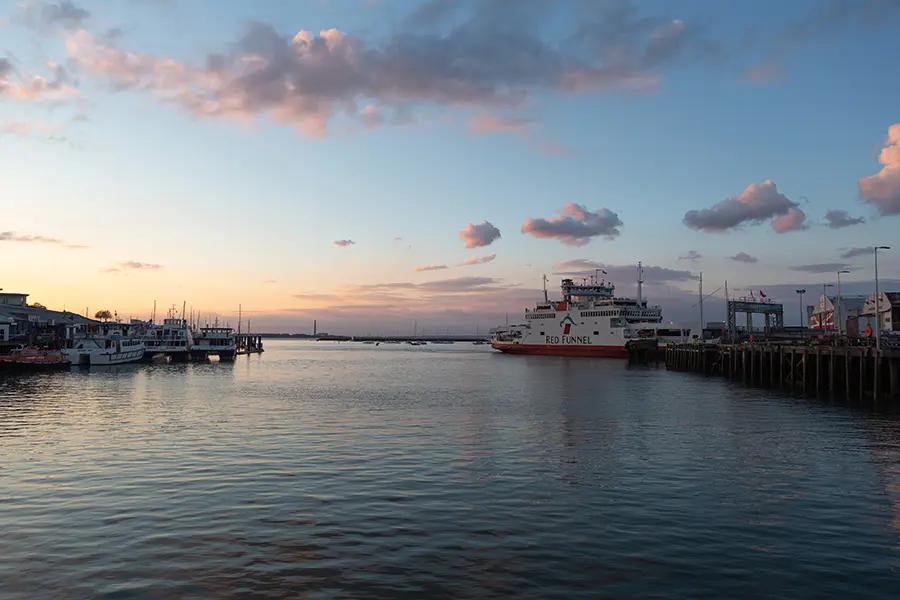
Can I take a caravan or motorhome on the ferries?
Yes, you can. You can often get packages through the ferry companies or discounts through the Caravan and Motorhome Club or Camping and Caravanning Club if you are a member of either club.
History of the Isle of Wight
The Smuggling history of the Isle of Wight
Going back hundreds of years, many families were involved in the import of illicit goods such as tubs of brandy and fleeces of wool.
Until the end of the 13th Century, the Isle of Wight was an independent principality and many local people disliked the rule from the mainland. This gave them a disrespect of the customs officials.
The town of Niton was perhaps the most notorious for this trade. Niton and Whitwell Parish Council have devised a Smugglers Trail for tourists to follow the pathway and hiding places favoured by smugglers in the old days.
Other smuggling sites include the Chines, Brook, Cowes, and the North Coast.
Ghost stories from the Isle of Wight
The island is acknowledged as the world’s most haunted island. There is a superstition that this high supernatural activity is due to the ‘ley’ lines running under the British island.
Some of the most famous Ghost Stories from the Isle of Wight are:
- Ventnor Botanics Ghostly Gardens
- St Catherine’s Lighthouse Ghost
- Knighton Gorges Disappearing/ Reappearing House
- Newport Ghost Train
- Appuldurcombe House Hauntings
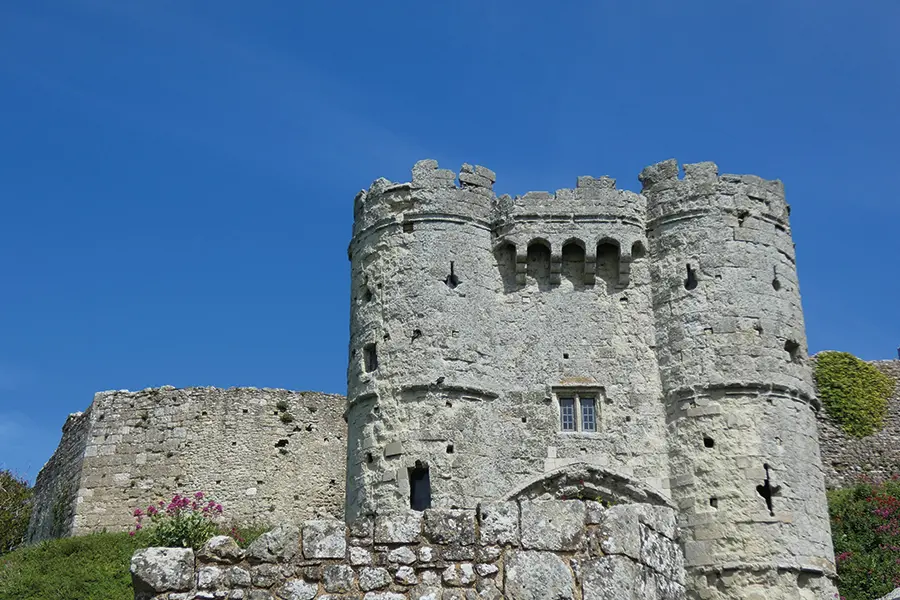
What is there to see on the Isle of Wight?
From natural wonders and sandy beaches for people who enjoy nature to charming castles and royal residences for history buffs, there is something to see for everyone.
There are also plenty of family-friendly amusement parks for a trip with friends and family to enjoy.
It is recommended to book a time slot for some of these activities due to popular demand.
Newport
Located in the centre of the island, Newport Town is the principal town of the island and is often referred to as the capital of the Isle of Wight. Newport is a historic county town with 2 elegant town squares with Georgian and Victorian architecture surrounding them.
Places to see in and around Newport
- Monkey Haven
- Carisbrooke Castle
- Robin Hill Country Park
The Northern part of the Isle of Wight
The town of Cowes is home to the oldest and biggest sailing regatta in the world. It is also the number 1 destination for sailors during the summer months.
What to see?
- Osborne House
- Egypt Point
- Northwood House
The Southern part of the Isle of Wight
South of the Isle of Wight lies the towns Ventnor, Sandown and Shanklin.
Ventnor is a traditional seaside resort and is famous due to its unique micro-climate. Sandown is a town sheltered by a bay, famed for its golden sandy beaches and seafront and pier. In Shanklin you’ll find a fantastic theatre as well as the Old Village which has pretty thatched cottages and tea rooms.
What to see?
- Ventnor Botanic Gardens
- Blackgang Chine
- Model Village Godshill
- Dinosaur Isle
The Eastern part of the Isle of Wight
The town of Ryde has long, spacious stretches of sandy beaches. It is one of the UK’s original seaside destinations and was much loved by Queen Victoria.
It has a thriving shopping scene and an amazing place for eating out filled with seaside fun and Victorian architecture.
What to see?
- Fantastic range of independent shops
- Ryde Beach
- Appley Beach
- Brading Town
The Western part of the Isle of Wight
One of the main entrances to the island by Ferry is Yarmouth town. It is a historic port town at the mouth of the River Yar and contains some of the oldest architecture on the island.
What to see?
- The Needles
- Yarmouth Castle
- Fort Victoria Country Park – Victoria’s Island Trail
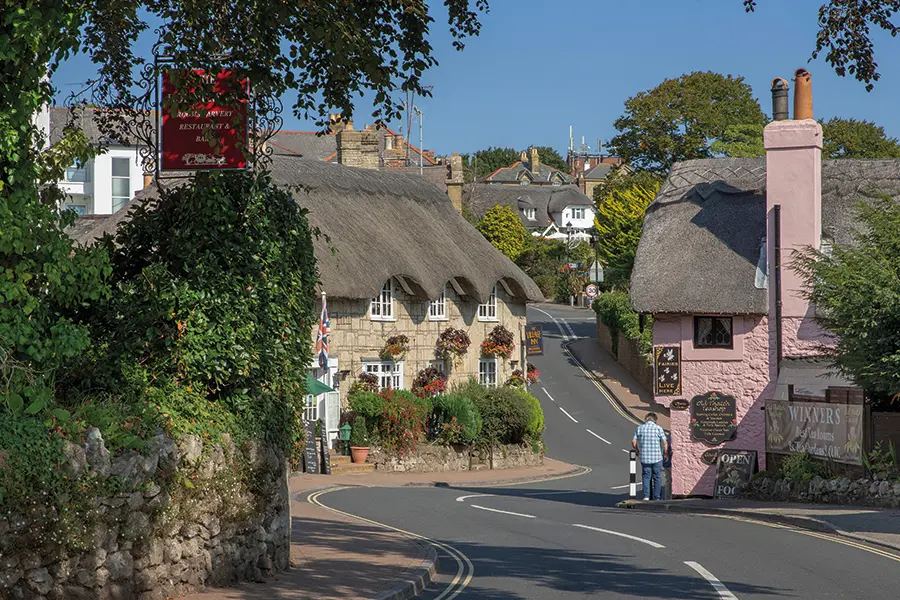
Where is best to eat and drink as I caravan around the Isle of Wight?
The Isle of Wight offers a wide range of delicious and unique eating and drinking experiences that will leave you wanting more for many years to come.
From fine dining and tasty pub grub to simple fish and chips by the sea and doorstep sandwiches, the island has so much to offer to foodies.
Take a look below to find suggestions for places to eat in each part of the Isle of Wight.
Newport
- Wheatsheaf Hotel
- The Bargeman’s Rest
- Toto
- Burrs
- Thomson’s Restaurant
The Northern part of the Isle of Wight
- Travellers Joy
- The Basque Kitchen
- Moocow
- Murrays Seafood Restaurant
The Southern part of the Isle of Wight
- Spyglass Inn
- Drunken Lobster
- Garlic Farm Restaurant
- The Bay Vegan Deli and Coffee House
- Old World Tea Rooms
The Eastern part of the Isle of Wight
- The Fishbourne
- The Fleming Arms
- ADA Mediterranean Restaurant
The Western part of the Isle of Wight
- Waterfront Bar and Restaurant
- The Piano Cafe
- The Cow Restaurant and Bar
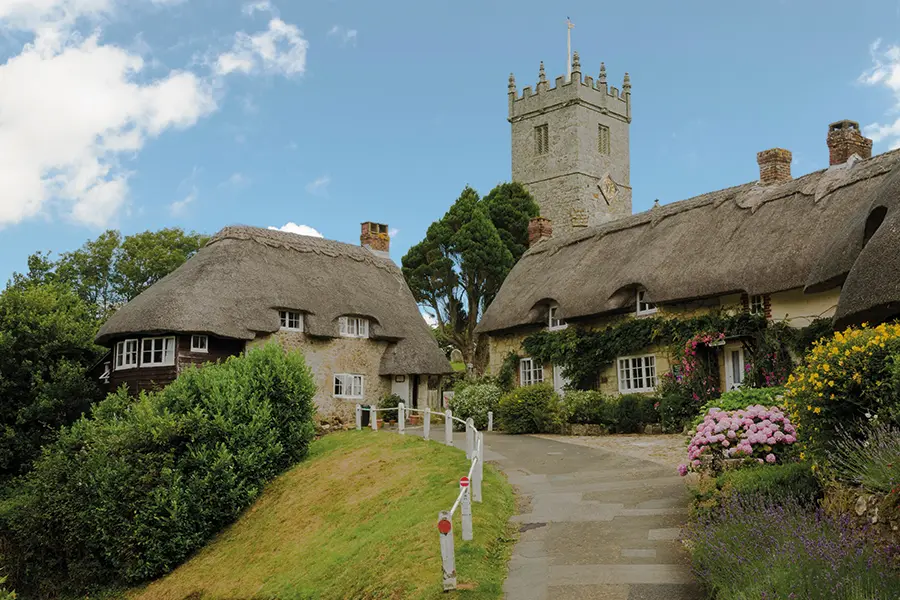
Before you head off
Want to find out more about the most popular UK and Europe Caravan and motorhome locations?
Read our latest articles on the best campsites to stay in:
Or view advice on:
- Beginner’s guide to caravan holidays
- Beginner’s guides to motorhome holidays
- Tips for travelling to mainland Europe



